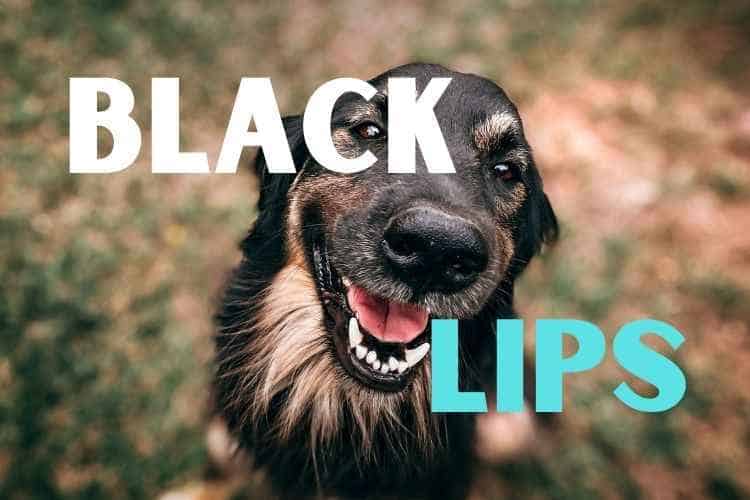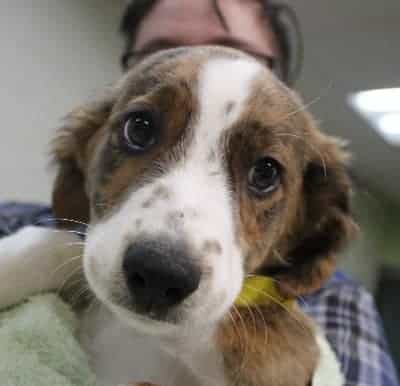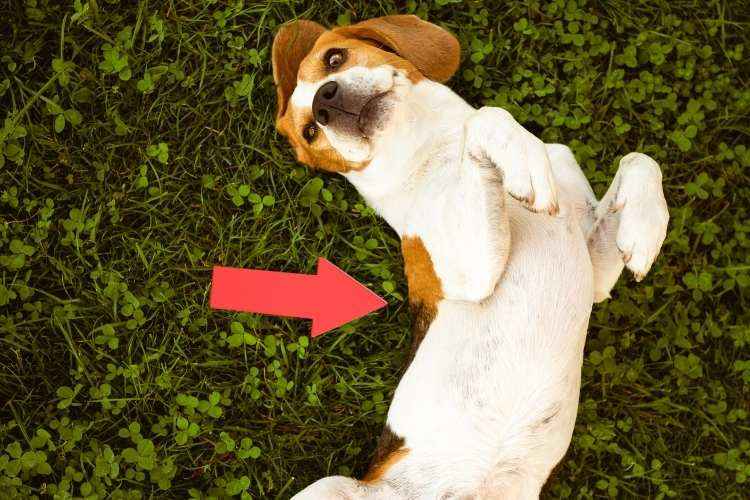Ultimate Guide to the Great Dane Beagle Mix (BeDane’s)
The Great Dane Beagle mix, what do they look like? They are so rare I had a hard time finding photos. It took me quite a bit of digging, but I managed to find two.
What is a Great Dane Beagle Mix?
The Great Dane Beagle mix is a cross-breed dog that results from breeding a Great Dane with a Beagle. Often, breeders use artificial insemination since the Great Dane is much bigger than the Beagle. Many breeders frown on this mix and view it as unethical, but clearly, some choose to breed them anyway.
Great Dane Beagle mixes are frequently called “Great Dangles” or “BeDane’s” by their owners. There aren’t many around, and puppies are hard to find.
Have you ever seen one? Let me know in the comments.
Appearance
The Beagle and Great Dane are incredibly different in appearance. When you mix two purebred dogs like this, the appearance can be unpredictable.
The Beagle Great Dane mix is not an official breed or even a popular crossbreed, so there is no standard for appearance. It will vary among litters and is dependant on which parent has the more robust genes.
You could end up with a dog that inherits most of its appearance from the Beagle and some from the Great Dane (shown in the photo).
Notice how it has long floppy ears and the coloring of a beagle. The skull, head, and face appear to be more like a Great Dane.
You could also end up with a dog that looks more like the Great Dane but has minor Beagle features.
The appearance is highly unpredictable!
Great Dane Beagle Mix Size & Weight
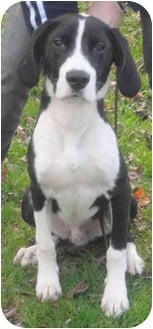
The size will be similar to one of its parent breeds or somewhere in between. You can use the information in the table below to get an idea of possible sizes.
| Beagle | Great Dane | |
| Height | 13 to 15 inches | 28 to 32 inches |
| Weight | 20 lbs to 30 lbs | 110 lbs to 175 lbs |
| Coloring | Tan, white, brown, lemon, red, blue | Various colors & patterns |
| Lifespan | 12 to 15 years | 8 to 10 years |
| Temperament | Energetic, Gentle, Social | Gentle Giant, Social, Energetic |
Personality
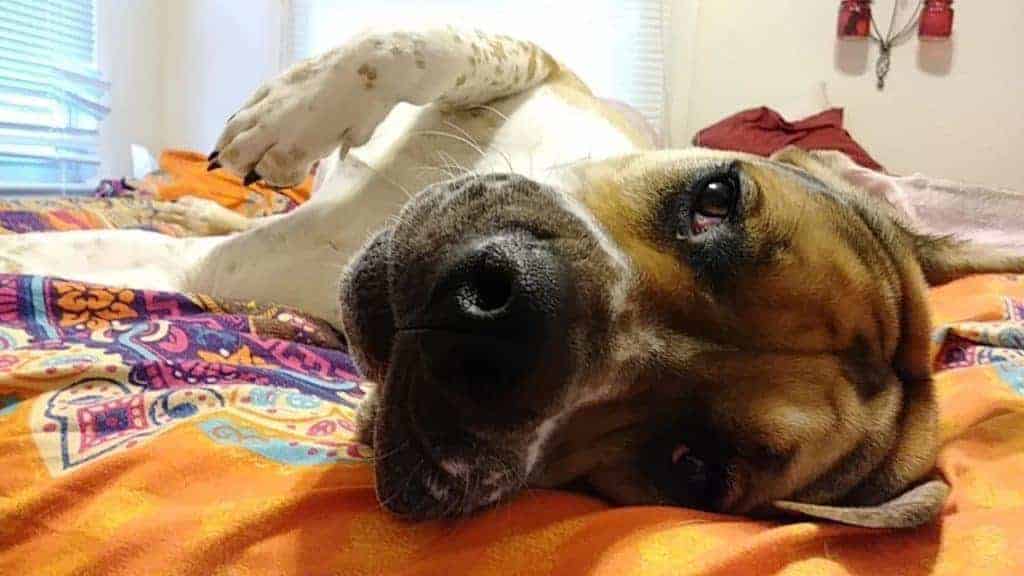
The BeDane should inherit a mixture of personality traits from both breeds. This is good news because both parent breeds have great personalities!
Great Dane Beagle Mixes have a sweet temperament and love to spend time with their family members. Both of its parent breeds are very social, and this trait is sure to be passed onto the pups.
They will love the outdoors as both breeds have been used as hunting dogs for centuries. Only the Beagle can track scents, as it’s a hunting hound. Your BeDane could inherit traits from either breed in this regard.
If your pup inherits the smelling ability of the Beagle, then food will be one of his primary love languages. It’s a big motivator for Beagles, but it also means they are prone to over-eat and can become overweight quickly.
They will probably have stubborn traits at times. Beagles are stubborn, and so are Great Danes. Even though they are usually happy when they don’t want to do something, they can put up a fuss.
Good With Kids
Great Dangles will get along well with children like the Beagle and Great Dane. They both have a protective instinct and can tell the difference between a child and an adult. Though they aren’t aggressive, they do stand up for their family, which is why this mix breed would likely make a good family pet.
Separation Anxiety
BeDane’s can develop strong bonds with their owners, which makes them fiercely loyal. Still, they may suffer from separation anxiety when left alone. This is common in both parent breeds and will likely pass onto the offspring.
Separation anxiety can cause a dog to get into trouble when left by himself. This is often due to stress and isn’t because a dog wants to spite its owners. It can be managed with proper handling and training and shouldn’t prevent anyone from getting a dog.
Grooming & Maintenance
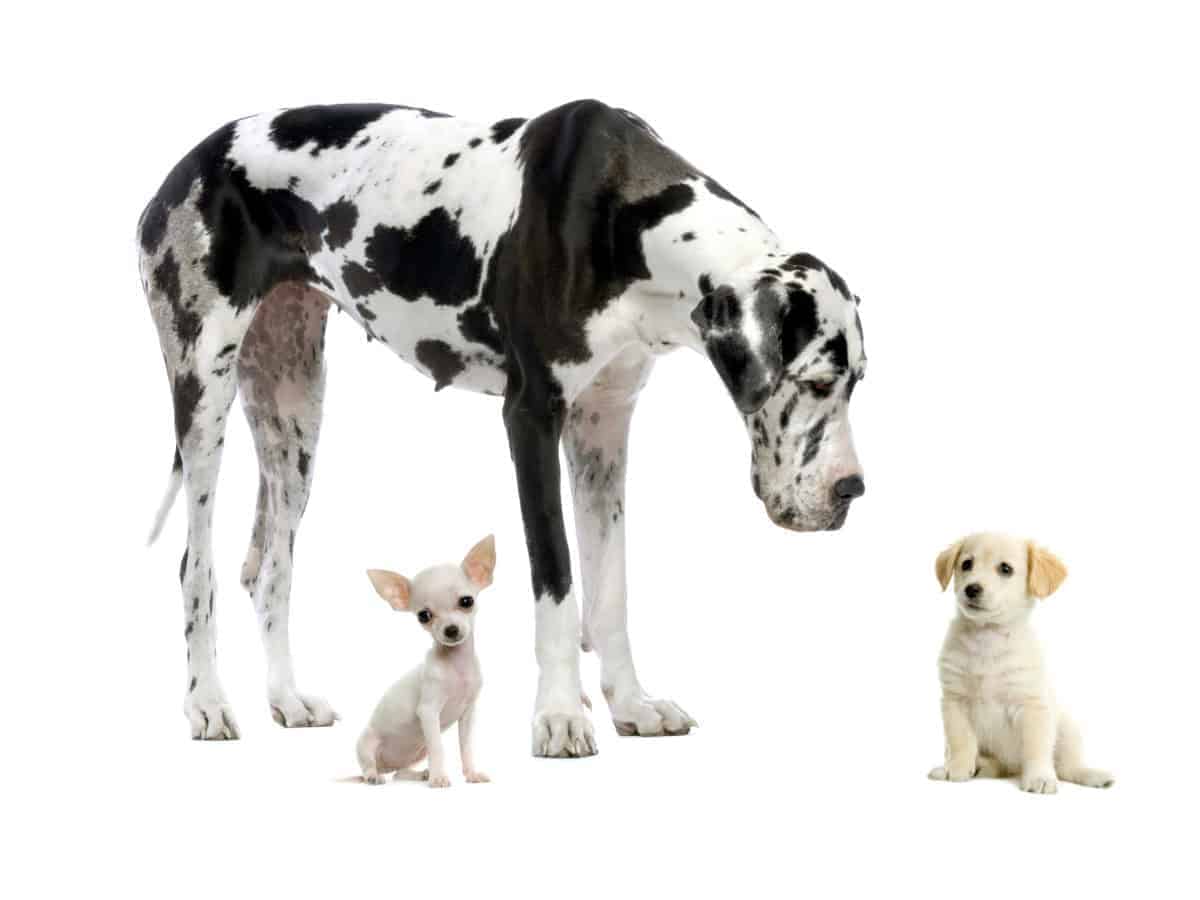
- Requires weekly brushing once or twice per week with a de-shedding come or brush
- Requires bathing every one to one and a half months
BeDane’s will inherit a short-haired coat that will shed. They will need to be brushed regularly to prevent their hair from getting all over the place. I recommend once or twice per week.
Beagles have a thick undercoat that causes them to shed a lot. BeDanes shed a good amount but not as much as the Beagle. It will depend on which coat your BeDane inherits, but you can expect him to shed a lot no matter which coat type he inherits.
Be prepared to vacuum regularly and invest in a good quality hair remover for clothing and furniture. It can be a pain to deal with dogs that shed a lot, but it can be managed.
You’ll want to invest in a high-quality de-shedding brush. I recommend the metal kind with a blade and is in the shape of a loop.
These work great for dogs that shed and are also used on horses. It has small jagged edges but doesn’t hurt the dog at all. My dog actually liked it as it must have felt like a massage to him.
Beagles are hound dogs, and hound dogs are known to stink. They produce more oil on their skin and have a unique smell.
There is a chance your BeDane will inherit this hound stink as well, so be prepared for it. It’s usually not that bad, but it can be.
Training a Great Dane & Beagle Mix
The Beagle & Great Dane mix will inherit both parent breeds’ above-average intelligence. He will likely be able to learn commands and tricks relatively quickly.
If he inherits the Beagle’s nose, he will learn almost anything if treats are involved.
Depending on which breed is more dominant in your BeDane will determine the type of training he can do. It mostly comes down to whether or not he has the nose of a hound or not.
If he does, he will be able to be trained to track scent trails. This can be fun since you can play games that involve hiding treats and having him find them.
Since both parent breeds have a stubborn quality, it can make training more difficult when they aren’t in the mood.
BeDane’s closer to Great Dane’s may have more stubbornness issues as they can’t be bribed as easily with treats, although I’m sure treats will work for some.
Exercise Needs
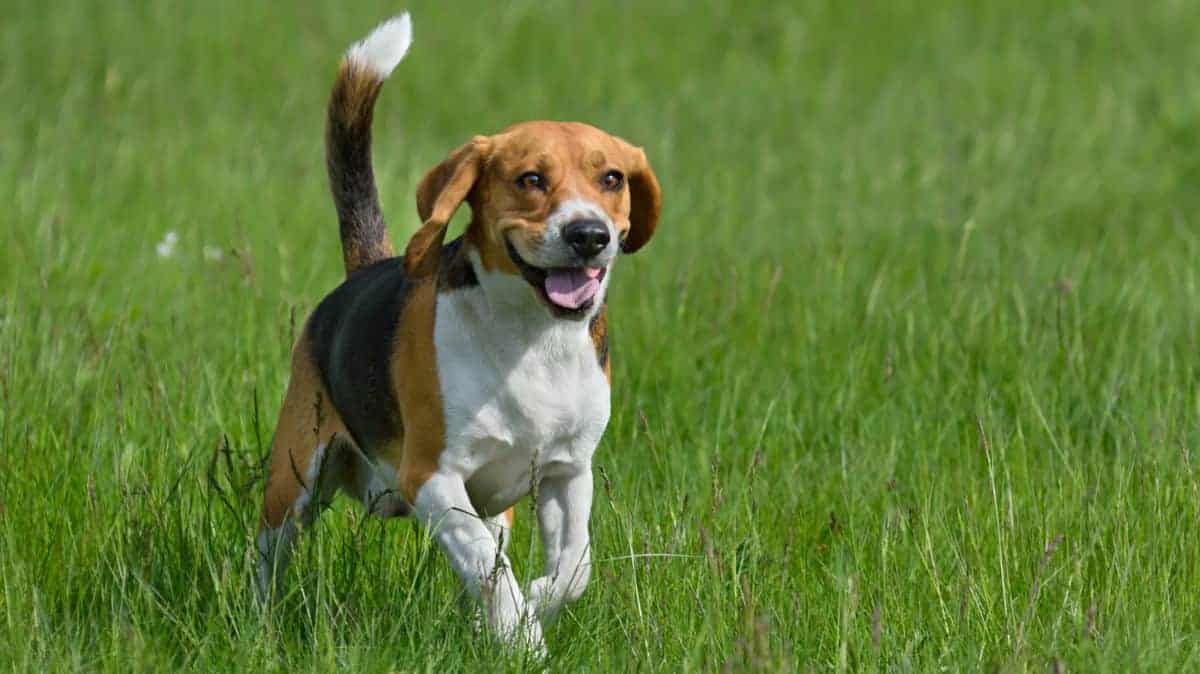
Beagle & Great Dane mixed dogs will need plenty of daily exercises as both parents have a lot of energy.
You should plan to exercise your BeDane a minimum of 30 minutes per day, but an hour a day would be ideal.
They love the outdoors since they are a cross between two hunting breeds. Taking them for a walk every day would probably be the best way to exercise them, but dog parks and other outside games would be ideal too.
They will like to play fetch if they inherited the Great Dane quality. Beagles don’t usually like to play fetch, as they’d rather smell the ground.
Feeding
The amount of food will depend on the dog’s size, which will depend on the genes of the breed your BeDane has inherited.
The brand of dog food you buy should have feeding recommendations based on weight, similar to the table I created below.
This table’s information is from a specific brand of dog food found on the Petco website. It doesn’t represent all dry kibble dog food. It’s meant to be an idea of what you can expect.
Follow the manufacturers’ directions of the food you are using and consult your veterinarian (I am not a veterinarian).
| Weight of Adult Dog | Cups Per Day (Dry Kibble) |
| 20 to 30 lbs | 1 ¾ to 2 ⅓ |
| 30 to 40 lbs | 2 ⅓ to 3 |
| 40 to 60 lbs | 3 to 4 |
| 60 to 80 lbs | 4 to 5 |
| 80 to 100 lbs | 5 to 5 ¾ |
| 100 to 125 lbs | 5 ¾ to 7 |
| 125 to 150 lbs | 7 to 8 |
| 150 to 175 lbs | 8 to 9 cups |
Source: Petco
Common Health Problems in BeDane’s
Since Beagle Great Dane mixes aren’t an official breed, they could have health problems associated with either parent breeds or both.
Hip Dysplasia is common in both parent breeds.
Common Beagle Health Issues
- Hip Dysplasia
- An inherited condition
- The thigh bone does not fit correctly into the hip joint.
- It may or may not be painful.
- May cause the dog to limp or bunny hop
- It can be fixed through surgery in some cases
- Needs to be managed by pain medication in other cases
- A reputable breeder should not be breeding dogs with this condition.
- Progressive Retinal Atrophy
- An eye disease
- Can progressively cause blindness
- Signs start to show as the dog ages
- Glaucoma
- Eye disease
- Causes pressure in the eye
- Produces fluid that needs to drain and, if it’s not able to, can cause damage to the nerve inside the eye and lead to vision loss.
- It can be treated with surgery and medication
- Cherry Eye
- Protruding gland under the third eyelid
- Resembles a Cherry
- Intervertebral Disk Diseases
- Spinal damage caused by problems with the discs in the spine
- Causes severe neck or back pain
- Can be progressive
- Surgery is an option but doesn’t always solve the problem.
Common Great Dane Health Issues
- Hip Dysplasia
- An inherited condition
- The thigh bone does not fit correctly into the hip joint.
- It may or may not be painful.
- May cause the dog to limp or bunny hop
- It can be fixed through surgery in some cases
- Needs to be managed by pain medication in other cases
- A reputable breeder should not be breeding dogs with this condition.
- Gastric Dilation-Volvulus
- Also called bloat.
- More common in large Goldendoodles
- Air becomes trapped inside the stomach, and the dog cannot burp it out.
- It can be Life-threatening and send the dog into shock
- Bone Cancer
- Also known as Osteosarcoma
- The most common bone tumors found in canines
- Can develop in larges breeds earlier in life than small breeds
- Difficulty walking and lameness is usually the first symptom
- Heart Disease
- Various heart diseases
History of the Great Dane Beagle Mix
The Great Dane Beagle mix is a designer dog, and because of this, there isn’t a lot of information available.
However, there is a lot of information available on its parent dogs, the Beagle and the Great Dane.
Great Dangles will inherit a mixture of qualities from both parent breeds, including appearance, temperament, and health problems.
So it’s helpful to understand the history of the two parent breeds.
Origin of the Great Dane.
The origin of the Great Dane is debated, and there are three theories on where they originated from. Though, there is seems to be some truth in all three.
Egypt
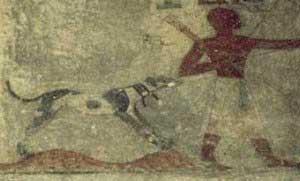
The first theory says that they can be traced all the way back to the Egyptians! Which would make them an ancient breed.
The people who argue this say that dogs that resemble Great Danes can be found on ancient hieroglyphs dating back to 3000 BC.
Denmark
The second version of history says that they originated in Denmark in the 16th century.
During the 16th century, Denmark experimented with a new hunting method. They wanted large dogs that would hunt and hold prey down until the hunters arrived.
There were no dogs strong enough for this, so King Frederick II of Denmark imported English mastiff puppies from Queen Elizabeth and mixed them with his dogs.
Mastiffs were powerful hunting dogs, and when mixed with King Fredericks dogs, the Great Dane was birthed.
Germany
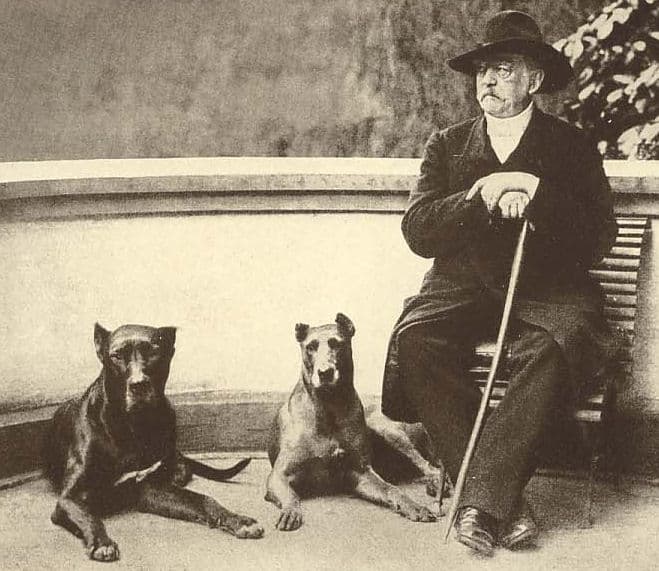
Great Danes first appeared in modern history in the 1800s in Germany. In 1888 the German Deutsche Doggen-Club set the standard for the breed.
Origin of the Beagle
The beloved Beagle has controversy around its history as well.
Some believe the breed’s name comes from the Gaelic word “beag,” which means “little.”
Others argue that it comes from the French word, “be’geule,” for the baying sound that beagles make when hunting.
One thing is for sure, Beagles have been popular hunting dogs for centuries.
Beagles became popular in the 1500s in England. Most English gentlemen had large packs of hound dogs used for hunting.
The Beagle was the smallest breed of the bunch and used for a particular purpose.
Larger hounds required their owners to be on horseback to keep up with them. Beagles, on the other hand, could be hunted on foot.
This is where they earned the nickname “foot hound,” as their owners were able to follow them on foot, without the need for a horse.
They were more accessible to people who couldn’t afford the expenses associated with having a horse.
Beagles became popular in the United States after the Civil War and were commonly used for hunting rabbits.
Final Thoughts
Since this is such a rare cross-breed not much is known about them. I did my best to collect and gather information on them. If you have experience with BeDane’s please tell me about it in the comment section below.

